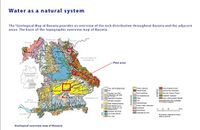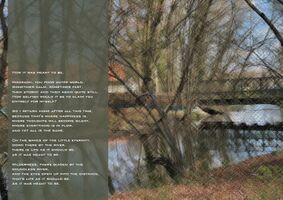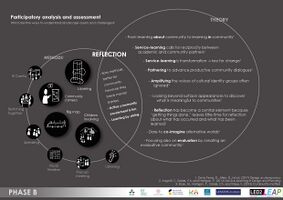Freising-Moosach Landscape Democracy 2022 Team 6
>>>back to working groups overview
For help with editing this Wiki page use this link.
For more details on assignments and key readings please use this link.
Landscape Democracy Rationale
Moosach is a 38-kilometre-long (24 mi) left tributary of the river Isar near Munich in Bavaria, Germany.
It could also be described as a tributary of the river Amper, because of the stream Mühlbach that splits away carrying
about 30% of the water just before the Moosach joins the Isar.
Moosach start from the northern part of Munich run through grass land, Freising ( where the project located ), Marzling and combine to Isar before arriving Moosburg.
Moosach is a place where people go for a walk, ride a bicycle and relaxing. Moosach run through downtown of Freising where there are a development project.
People can sit close to the river and enjoy their time. So we can say that Moosach is relate to Freisinger and be a part of their daily life.
The main landscape democracy challenge here is to make river Moosach more visible to residents and people,
create an emotional connection with it, make access to the river more open.
And at the same time preserve the biodiversity and the local ecosystem of river Moosach.
Location and Scope
Phase A: Mapping Your Community
Welcome to Your Community and Their Landscape
- The plan area is located in the southern part of Munich, Germany. The landscape is characterized by a large amount of farmland and small towns.
- The landscape is formed by the large hills in the northern part of the plan area. The southern part of the area is a large valley. Freising is a small town in the north of Munich close to Munich Airport.
- Freising is one of the oldest town in Bavaria with population around 49,000. There are 2 universities, Technical University of Munich and Weihenstephen Treisdof University of Applied Science.
Groups of Actors and Stakeholders in Your Community
The most important stakeholders in this landscape are the most unheard.
We included Flora&Fauna and the river itself as a stakeholder in the process.
The needs and interests of the stakeholders are a great entrancepoint for the further design process.
Relationships Between Your Actors and Groups
There is a discrepancy between the fysical power in the landscape and the financial power. The stakeholders with the largest responsability for the landschape, like for example farmers, are not able to meet these expectations because of financial reasons. On the other hand. The airport is a large and growing stakeholder in this landschape. The power dynamic between stakeholders gives a clear view of the stakeholders most in need. Flora&Fauna are needed for almost every stakeholder but is seen as a resource.
Summary of Your Learnings from the Transnational Discussion Panel
The Transnational Discussion Panel was very useful for our team. Mainly because working with different people from different countries, specializing in different fields,
made it possible to find out how the vision can differ. We have received a lot of useful feedback, both from interested parties and from specialists.
We learned how the opinions of stakeholders can differ depending on various factors and how in our projects we need to find a balance between the main task
and the opinions of all stakeholders. Another important factor is that not all stakeholders have equal influence and not all of them have the same power to make key decisions.
In this case, we found a very useful method of creating a power map, on which you can clearly see all the stakeholders, their powers, influence, as well as interaction with each other.
Theory Reflection
According to European Landscape Convention the definition of landscape is “landscape is a part of the land, as perceived by local people or visitors,
which evolves through time as a result of being acted upon by natural forces and human beings.” In the reading "Landscape Culture - Culturing Landscapes"
Olaf Kühne and Marc Antrop also looked at how the landscape is connected not only with the land and history, but also with people
and how they perceive it - what emotions they experience in relation to this landscape, what memories they have, how they perceive this landscape in general.
“ The people at the heart of landscape policy” This sentence show that all the parties are important and can be part in one or another role in the landscape design.
The most important thing we have taken from these texts is that the landscape is not just a place or land. The landscape is invariably connected with people,
and not only because people physically change it, but also on a mental level. All emotions, memories, all spiritual connection - all this is also part of the landscape.
And, as landscape architects, our task in the arrangement is also to create and preserve this emotional connection between people and the landscape.
Because this is one of the most important parts of creating a sustainable landscape.
From Pledge for a Transformative Science " Students are encouraged to look at local sustainability problems from various perspectives,
taking into account the discourses and practices of various stakeholder, and to develop a deeper understanding of the ambiguities,
uncertainty and multidimensional nature of sustainability transformations" This mean that the new study aim to focus on the public participation and reduce the boundary between specialists and public.
References
- Landscape Convention Contribution to human rights, democracy and sustainable development (Council of Europe, 2018
- Council of Europe (2000):The European Landscape Convention
- Kühne, Bruns et al: Landscape Culture - Culturing Landscapes
- Uwe Schneidewind, Mandy Singer-Brodowski, Karoline Augenstein and Franziska Stelze : Pledge for a Transformative Science
Phase B: Democratic Landscape Analysis and Assessment
Louisa Schleicher - Poem " How it was meant to be"
Pasu & Monika - Poem " My Dear Moosach"
Jaromir Janszen Take stand against a third runway at Munich Airport
Anastasiia - Poem "Invisible river"
Farhin
Phase C: Collaborative Visioning and Goal Setting
The Scene in Story of Visioning
- Landscape Democracy Challenge
The Actors in Story of Visioning
- Introduce actors - Student , Farmer, Hotel Owner, Governor, City dwellers and Landscape Architect
The Story of Visioning
- The story is about a poor student who has to ride a bicycle to university every day. He proposed his idea to built a bicycle path along the Moosach to the governor and the storyline of the design process.
Reflect on Story of Visioning
- Vision, Goals and Plans for this project including reflection on the vision.
Phase D: Collaborative Design, Transformation and Planning
Your Prototyping Action
- Making a Bicycle path from Freising to Pulling along the Moosach for all the people to use this path and become a recreation area for all citizens.
The Evolution of Your Prototyping Action
- All the stakeholders can come to comments and the final is to have a specialist to adjust the bicycle path for the safety issue.
The Plan Behind Your Prototyping Action
- Plan a bicycle route along the Moosach which have different view and landscape scenery.
The Realization of Your Prototyping Action
- All the stakeholders can involve in this prototype, give their comments, and adjust.
Reflect on Your Prototyping Action
- After having the agreement and finally adjusting from a specialist. We can construct the bicycle path along the Moosach as we planned.
Phase E: Collaborative Evaluation and Future Agendas
Collaborative Evaluation and Landscape Democracy Reflection
- The involvement of users in Living Labs is a complex and ethically challenging task. In any type of development activities that involves human participants, it is important to consider ethics. The European Commission developed guidelines for ethics self-assessment for projects addressing human participants (EC, 2019). The guidelines apply to Living Labs, as Labs are based on the participation of humans and often involve collection of personal data from Living Lab actors, interviews, observations, tracking and the secondary use of information provided for other purposes.
- Addyouruniqueimagename.jpg
insert text here
- Addyouruniqueimagename.jpg
insert text here
- Addyouruniqueimagename.jpg
insert text here
The Actors in your Collaborative Evaluation
- European Living Labs are based on five key elements: active user involvement, a real-life setting, multi-stakeholder participation, a multi-method approach, and co-creation. From an ethical point of view, these elements represent a number of challenges. Ethical challenges related to Living Labs are usually associated with participatory research ethics, emphasizing participant engagement and ethical codes of conduct related to participant privacy and consent, i.e., the user involvement element.
Reflection on the Online Seminar
- Online seminars give us a big chance to imagine and improve our creative skills to build castles in the air.
- Addyouruniqueimagename.jpg
insert text here
- Addyouruniqueimagename.jpg
insert text here
- Addyouruniqueimagename.jpg
insert text here
Reflection on your Living Lab Process
- Living Labs is a concept used mainly in the context of collaborative development aimed at solving complex societal needs. According to Björklund et al. (2017), collaboration can be defined as the transfer of knowledge from one party to another in an open and safe environment where all actors give and receive valuable information and ideas. This process may also be referred to as co-creation, which is understood as defining and solving shared problems with a systematic approach in close cooperation with multiple actors of diverse backgrounds.
- Addyouruniqueimagename.jpg
insert text here
- Addyouruniqueimagename.jpg
insert text here
- Addyouruniqueimagename.jpg
insert text here
Your Living Lab Code of Conduct
- The involvement of users in Living Labs is a complex and ethically challenging task. In any type of development activity that involves human participants, it is important to consider ethics. The European Commission developed guidelines for ethics self-assessment for projects addressing human participants (EC, 2019). The guidelines apply to Living Labs, as Labs are based on the participation of humans and often involve the collection of personal data from Living Lab actors, interviews, observations, tracking, and the secondary use of information provided for other purposes.
- Addyouruniqueimagename.jpg
insert text here
- Addyouruniqueimagename.jpg
insert text here
- Addyouruniqueimagename.jpg
insert text here
Process Reflection
- Living Labs is a concept used mainly in the context of collaborative development aimed at solving complex societal needs. Collaboration can be defined as the transfer of knowledge from one party to another in an open and safe environment where all actors give and receive valuable information and ideas. This process may also be referred to as co-creation, which is understood as defining and solving shared problems with a systematic approach in close cooperation with multiple actors of diverse backgrounds.






































